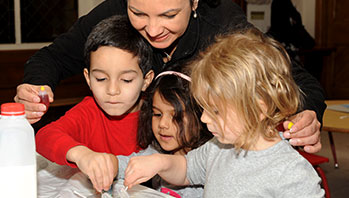- bag collections
- clean food trays (one for each child)
- clipboard
- magnifying lenses
- masking tape (to write labels)
- pen
- plastic containers
- collection
- leaf
- plant
- root
- seed
- stem
MA Standards:
Language/L.PK.MA.6: Use words and phrases acquired through conversations, listening to books read aloud, activities, and play.
Head Start Outcomes:
Logic and Reasoning/Reasoning and Problem Solving: Classifies, compares, and contrasts objects, events, and experiences.
Science Knowledge/Scientific Skills and Method: Observes and discusses common properties, differences, and comparisons among objects.
PreK Learning Guidelines:
English Language Arts/Language 2: Participate actively in discussions, listen to the ideas of others, and ask and answer relevant questions.
Mathematics/Patterns and Relations 8: Sort, categorize, or classify objects by more than one attribute.
Small Group: Sorting Parts

© Commonwealth of Massachusetts, Department of Early Education and Care (Jennifer Waddell photographer). All rights reserved.
STEM Key Concepts: There are many different types of plants; Many foods that animals, including humans, eat come from plants; Plants have different parts: leaves, roots, stem, flowers, and seeds
ELA Focus Skills: Listening and Speaking, Vocabulary
Tell children they are going to sort their collections. Point out the plastic containers and explain that they can sort their items in these containers. Ask children to empty their collections onto their food tray so they can see all the plant parts they collected. As children look at their collections, ask, What are some ways we can sort the items into groups? Record children’s answers, for example,
- Plant parts (roots, stems, seeds, etc.)
- Plants animals eat/don’t eat
- Leaf shape or size
- Hard/soft
- Color
Help children write a label for their containers once they determine how they will categorize the parts. Allow children to categorize in different ways. As they examine their plants ask questions such as,
- Which plants do you think animals eat? Why do you think so?
- What do you notice about the color of all the leaves in your collection? What about the color of the seeds?
- How are the seeds in your collection like the sprout seeds? How are they different?
